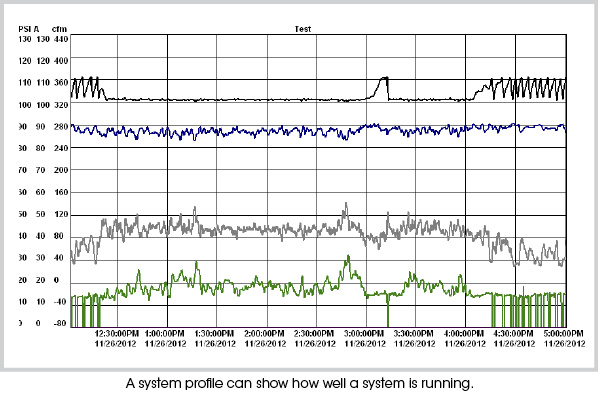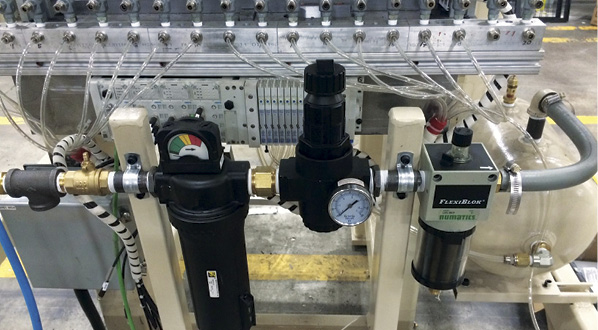Measure Compressed Air Efficiency and Save
Air compressors and dryers are usually decked out with a good set of gauges to measure pressure and temperature, but rarely is there anything that shows the efficiency of your system and the level of waste. Compressed air is one of the most costly utilities in a typical facility, yet systems are often left to run unchecked. If you want your compressed air system to run at maximum performance, you will have to take matters into your own hands.
How Should Your Compressor Run?
In a compressed air system, it is very important to always maintain adequate pressure so that tools, machines, and processes run uninterrupted. To be able to maintain a constant pressure, you must put in exactly the same amount of air that your production equipment is consuming. Put in less, and the pressure falls; put in more, and the pressure rises. This requires you to run enough air compressor capacity to handle the average flow and the peak flows.
But what does it cost to do this? There are many different ways to maintain pressure. You could run one compressor sized to handle both peak and average flows. The efficiency of this compressor might be very good at peak flows, but extremely poor at average loads. Perhaps two compressors might be used, and then two compressors could be run at peak flows, with one compressor unloading and perhaps turning off during average flows. This strategy might be more efficient than the one compressor idea. There could be other options. But how much more efficient is one option over the other? To answer this question, some measurements need to be taken.

What Needs to be Measured?
The best way to get a handle on how your system is running and how it can be improved is to measure its key characteristics. A good set of data needs to be taken of various pressures, power consumption, and flow. It is recommended that these measurements be taken together at the same time so that analysis of the interaction of the various components that are working together can be done. Often data loggers are used that capture a typical production cycle—say, a full week or a month. Then the data can be analyzed, much in the same way as a doctor might look at an EKG, to reveal problems and opportunities.
For example, measuring the system pressure at various points, such as at the compressor discharge, after the air dryer and filters, and at various points near critical machines, can show you where restrictions to flow might be choking your machine performance. This can reveal undersized components, undersized piping, clogged filters, and faulty valves and fittings, or even a lack of compressor capacity.
Measuring compressor power can reveal problems with compressor control. For example, your air compressor might be inadvertently running in an inefficient operating mode. Since compressors don’t have power meters, you may not be aware of this until you look at your power data. And perhaps you have compressors that are running unloaded for no reason. Air compressors can run for significant periods without producing air, still consuming significant power but not turning off because somebody forgot to set the auto-shutdown feature.
Capturing a flow profile can show how the plant uses compressed air. Once obtained, this can go far in showing you how you need to run your air compressors and which ones should be running at any one time. The flow profile can also show your level of waste. For example, examining the flow level during periods of non-production can show how much air is being consumed by plant leaks and equipment that is left on and wasting air.
The measured parameters can be used to do analysis on how efficiently your air compressors are producing air. If, for example, you know your air compressors are rated to consume 20 kilowatts for every 100 cfm they produce but your measurements reveal your compressors are consuming three times this level, you know you have a potential opportunity for improvement.
Who Measures?
If you are a do-it-yourselfer, it is fairly easy to buy or rent affordable instrumentation that can gather this necessary information. And with some adequate training and a bit of experience, you or your staff can become proficient in reading the compressed air system pressure/power/flow profiles. Best-practice systems have a set of permanently installed instruments constantly recording system operations.
If you couldn’t be bothered, but you are interested in learning how your system is running, most compressor vendors can offer data logging of your system, sometimes provided free of cost, especially if you are in the market to purchase some new, more efficient equipment.
In some locales, there may be some independent compressed air auditing companies that specialize in monitoring systems. It often pays to search for different options in your area. Often power utilities or energy-efficiency organizations will give a rebate if there are costs associated with such study. And they might pay even more to help implement efficiency projects. A good auditor will get you connected to this funding source.
How will you benefit? Well, a typical 75-hp compressor running full-time might consume about $45,000 per year in electricity costs and even more in maintenance costs. Often savings of 10-20% can be achieved without even breaking a sweat or spending much money by implementing low-cost, no-cost measures. More aggressive savings of 20-50% are typical, and saving 75-80% is possible in a few circumstances.
By Ron Marshall for the Compressed Air Challenge
Learn more about measuring compressed air efficiency at one of the Compressed Air Challenge seminars or download a fact sheet from the website library. For a schedule of events, visit www.compressedairchallenge.org.







